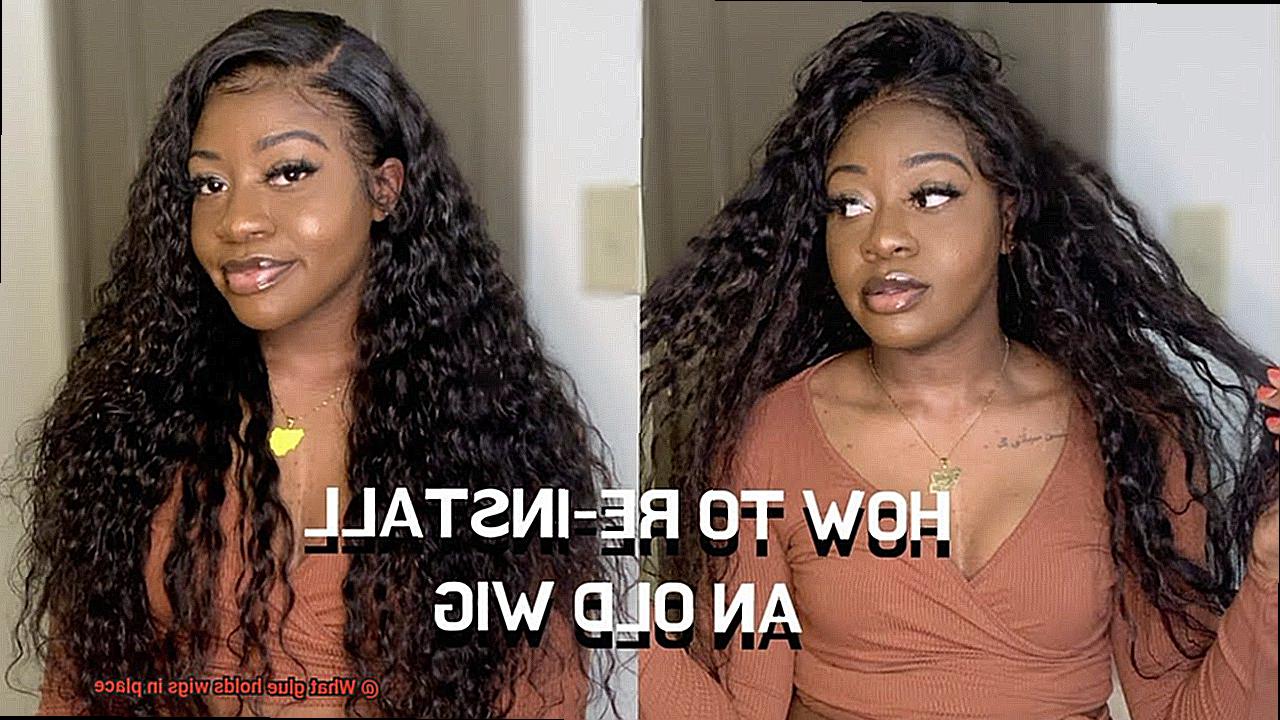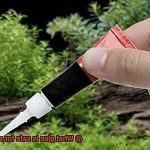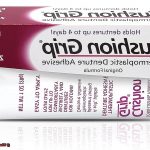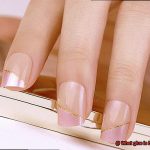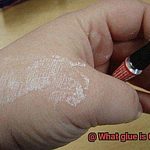Do you ever wonder how some people can wear wigs without any embarrassing mishaps? Well, let me share a little secret with you – it’s all about the glue. That’s right, glue is the unsung hero that holds wigs in place.
But not just any glue will do. Wig glue is specially formulated to be safe for use on skin and provide a strong hold that lasts for hours. You might be thinking, “What kind of glue are we talking about here?” The answer is simple: wig glue.
In this post, we’ll explore the different types of wig glue available, including liquid, spray, and tape. Each has its own unique advantages and disadvantages depending on your preferences and the type of wig you’re wearing.
But how does it actually work? And is it easy to apply and remove? These are just a couple of questions we’ll answer as we dive deep into the world of wig glue.
Whether you’re an actor prepping for your big performance or simply trying out a new hairstyle, knowing what glue holds wigs in place is crucial. So buckle up and get ready to learn everything there is to know about wig glue.
Types of Glue for Wigs
Contents
There are several types of glue available for securing wigs in place, each with its own unique set of properties. Let’s explore these types of adhesives and their features in more detail.
Spirit Gum:
Spirit gum is a traditional adhesive that has been used for decades to secure wigs. Made from natural gum resin, it’s applied using a brush and dries clear. Spirit gum is popular among artists and performers, but may not be the best choice for extended wear or high humidity.
Liquid Latex:
Liquid latex is a type of rubber that can create a skin-like surface on the scalp. It’s flexible and can be used to create a strong bond between the wig and scalp. It’s perfect for creating a natural-looking hold and can be removed easily.
Hairpiece Tape:
Hairpiece tape is a double-sided tape that’s easy to apply and remove, making it perfect for those who want to wear their wigs temporarily. It comes in different shapes and sizes, and some tapes are even waterproof.
Wig Adhesive:
Wig adhesive is specifically designed for use with wigs and hairpieces. It comes in liquid or cream form and creates a strong bond between the wig and scalp, making it ideal for people who want to wear their wig for an extended period.
Silicone Adhesive:
Silicone adhesive is a newer type of adhesive that creates a strong, flexible bond between the wig and scalp. It’s waterproof, making it great for those who want to wear their wig while swimming or participating in other water activities.
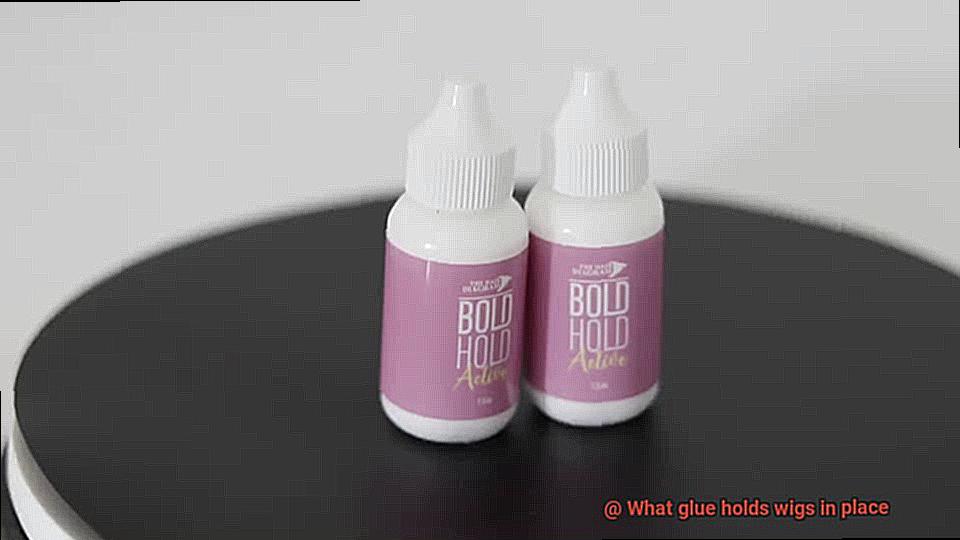
When choosing an adhesive for your wig, it’s crucial to consider factors such as your skin type, the type of wig you’re wearing, how long you’ll be wearing it, and the activities you’ll be participating in. A patch test should always be performed on a small area of skin before applying any adhesive to ensure there are no adverse reactions.
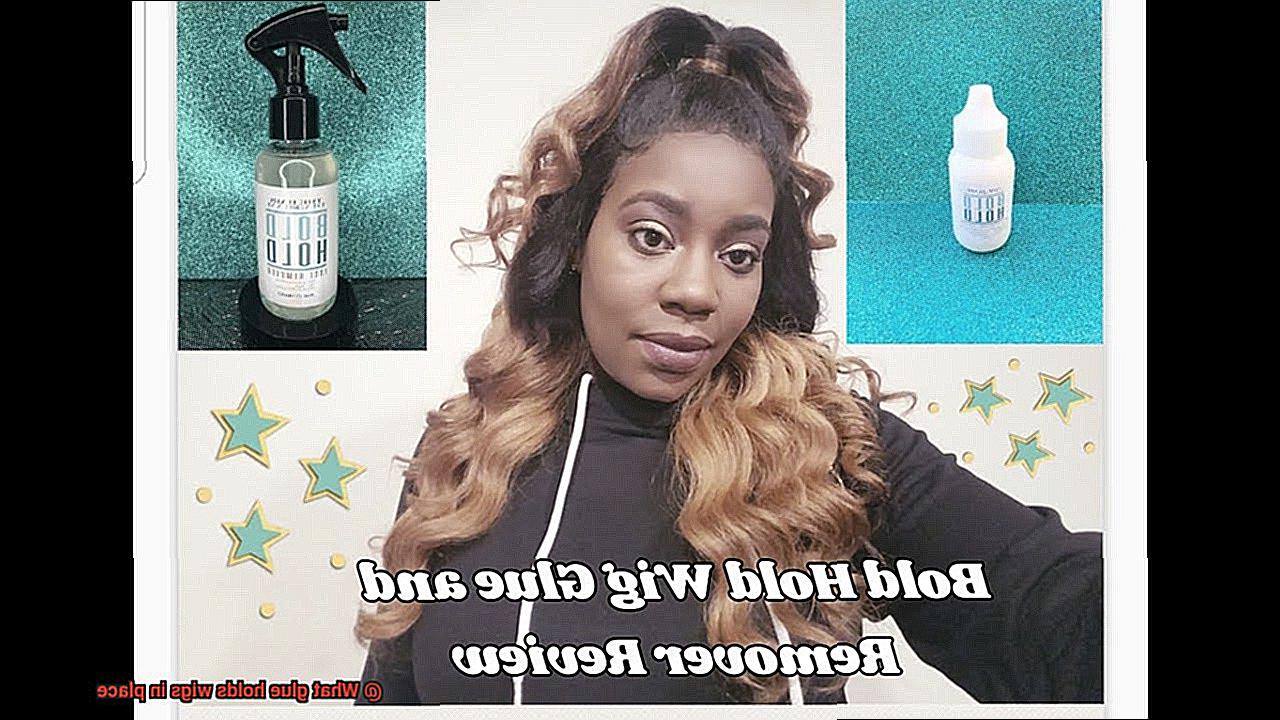
In conclusion, there are several types of glue available for securing wigs in place, and each has its own unique features. Whether you choose spirit gum, liquid latex, hairpiece tape, wig adhesive, or silicone adhesive, the right glue will help you achieve a secure and natural-looking hold for your wig.
Lace Wig Glue
Lace wig glue is here to save the day. However, with so many options available, it can be overwhelming to choose the right one. Let’s take a closer look at the advantages and disadvantages of different types of lace wig glue.
Water-based glue is a gentle option that is perfect for those with sensitive skin. It’s also easy to remove and great for beginners. However, it may not provide as strong of a hold as other types of glue, so it may not be the best choice for those who need a more secure hold or participate in high-energy activities.
Solvent-based glue creates a stronger hold and can last for weeks. It’s ideal for those who need a more secure hold or participate in activities that may cause the wig to shift or move around. However, it’s important to use caution when using solvent-based glue as it can be harsher on the skin and hairline. It’s also more difficult to remove than water-based glue.
No matter which type of lace wig glue you choose, it’s crucial to use it with caution. Overusing or applying too much can cause damage to the hairline and scalp. Always choose a reputable brand of glue and follow instructions carefully.
Spirit Gum
Look no further than spirit gum – the adhesive superhero that can keep your wig securely in place for hours on end. But before you dive in, let’s go over some essential steps to ensure a flawless application and avoid any unwanted skin irritation.
First and foremost, make sure to clean the area where you’ll be placing your wig. This is crucial for optimal adhesion and to prevent any unwanted slippage. Now it’s time to apply the spirit gum. You can use a small brush or cotton swab to carefully brush the adhesive onto your scalp or hairline.
Wait a few seconds for the spirit gum to become tacky before placing your wig on top. This will ensure a strong hold that can last for hours, even during high-energy performances or cosplay events. However, it’s important not to overuse spirit gum, as it can cause skin irritation or allergic reactions in some people. It’s always a good idea to perform a patch test before using it on a larger area.
Here are some additional tips and tricks for using spirit gum:
- Use a small amount of adhesive at first, and add more as needed.
- If you need to adjust your wig, gently lift it from one side and reapply the spirit gum as necessary.
- To remove the wig, gently peel it off from one side and use alcohol or another adhesive remover to dissolve any remaining spirit gum.
Hypoallergenic Glues
As someone who understands the importance of finding the right adhesive for wigs, I’m excited to share my knowledge on hypoallergenic glues. These specialized adhesives are a fantastic option for individuals who want to securely attach their wigs without risking skin irritation or allergic reactions.
One of the most significant benefits of hypoallergenic glues is that they are formulated to reduce the risk of allergic reactions. These adhesives are made with natural ingredients such as aloe vera, chamomile, and vitamin E, which can help soothe and protect the skin. They are also free from harsh chemicals like formaldehyde and toluene, which can cause allergic reactions and skin irritations.
While hypoallergenic glues may not be as strong as traditional adhesives, there are numerous popular options available in the market. Some top picks include Spirit Gum by Mehron, Proclaim Super Bond Hair Glue, and Duo Brush-On Striplash Adhesive. Before using any glue, it’s essential to do a patch test on a small area of skin to ensure that there is no adverse reaction.

One thing to note is that individuals may need to reapply hypoallergenic glues more frequently throughout the day due to their reduced strength. However, many people find that the benefits of using hypoallergenic glues outweigh this slight inconvenience.
Benefits of Using Glue for Wigs
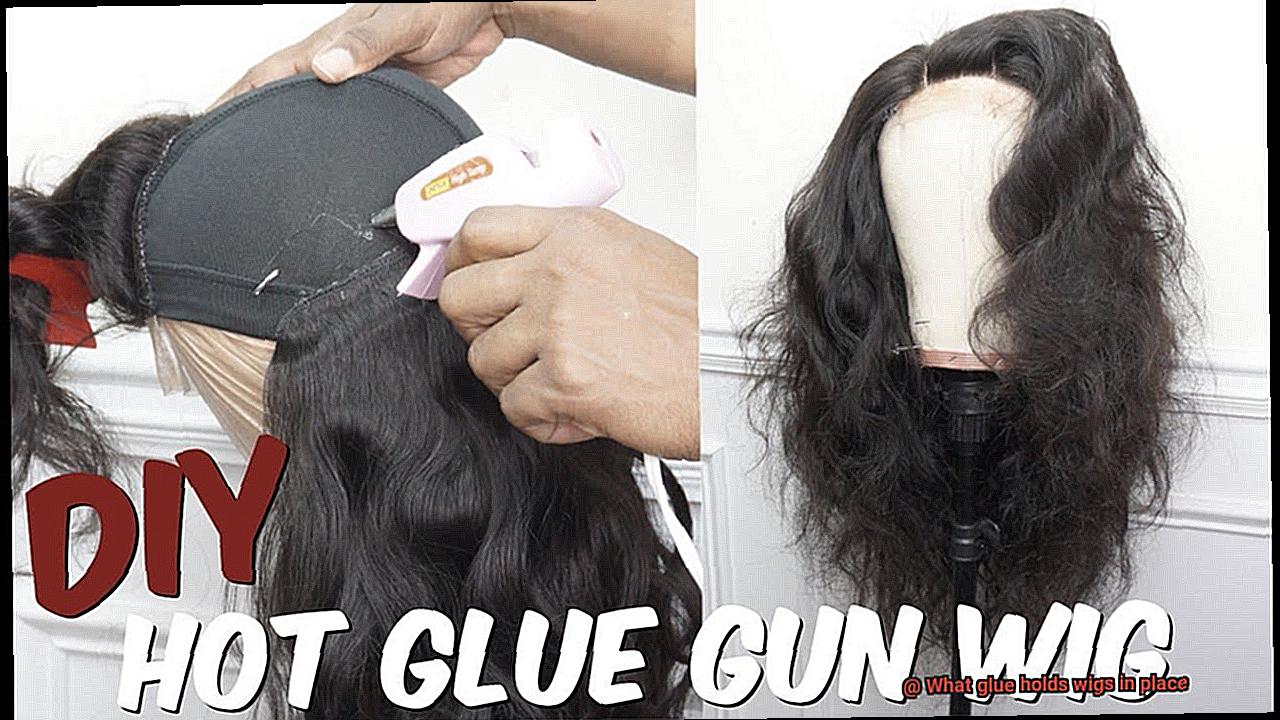
Look no further than glue for wig attachment. Glue offers a multitude of benefits that make it one of the most popular ways to secure wigs in place.
Firstly, glue provides a long-lasting hold that keeps your wig securely in place all day long. No more worrying about your wig slipping or sliding out of place, especially if you lead an active lifestyle or live in a windy environment.
One of the greatest advantages of using glue is its versatility. It works with any type of wig – lace front, full lace, or u-part wigs. This means that you have the freedom to choose any wig style you desire without worrying about how to keep it securely in place.
Perhaps the most important benefit of using glue is achieving a natural-looking hairline. The seamless look created by the glue mimics your natural hairline, making it difficult for anyone to tell that you are wearing a wig. This is especially crucial for those who wear lace front wigs, as the lace front requires a natural-looking hairline to blend seamlessly with your skin.
Applying glue to your wig is easy and straightforward, with a little bit of practice, you can master the technique and apply the glue quickly and efficiently.
Lastly, using glue does not damage your natural hair. Unlike other methods of wig attachment like sewing or braiding, glue ensures that your hair remains healthy and protected while wearing a wig.
How to Apply Wig Glue
Here are some steps to follow:
Choose the Right Glue
To ensure a successful application, you need to choose the right type of glue for your needs. Opt for a wig glue that is specifically designed for wig use, as regular hair glue or other adhesives may not be strong enough or may cause damage to your scalp or natural hair. You can consult with a wig specialist or do some research to find the best option for your wig type and lifestyle.
Clean and Dry Your Scalp
Before applying any glue, it’s crucial to clean and dry your scalp thoroughly. Any natural oil or residue can interfere with the adhesive’s effectiveness, so use an alcohol-based cleanser or other gentle cleanser to remove any oils or dirt from your scalp. Make sure to let it dry completely before applying the glue.
Apply Glue Evenly
Using a small brush or applicator, apply a thin layer of glue onto your scalp. Spread it evenly over the area where the wig will be attached, avoiding applying too much as it can create lumps or bumps under the wig. Begin at the front hairline and work your way back, leaving about half an inch of space between the hairline and the edge of the wig cap.
Wait for Glue to Become Tacky
After applying the glue, wait for a few seconds to let it dry and become tacky. You can test its tackiness by gently tapping on it with your finger. If it feels sticky but doesn’t come off on your finger, it’s ready for the wig to be applied. This step is crucial in ensuring that the wig stays in place and doesn’t shift around.
Attach and Style Your Wig
Carefully place the wig onto your head, starting from the front and adjusting it as needed. Press down on the wig firmly to secure it in place, using a comb or your fingers to smooth out any bumps or air pockets. Avoid applying too much pressure or tension on the wig to prevent discomfort or damage to your natural hair. Once the glue is completely dry, which usually takes about 10-15 minutes depending on the type of glue used, you can style your wig as desired using heat tools or other styling products.
How to Remove Wig Glue
If you’re looking to remove wig glue safely and effectively, you’ve come to the right place. Wig glue can be tricky to get off, but with the right techniques and tools, you can remove it without damaging your wig or scalp. Here are five sub-sections to guide you through the process:
Gather Your Supplies
To remove wig glue, you’ll need a few supplies. You’ll need a wig adhesive remover, a cotton ball or pad, and a comb or brush. These tools will help you remove the glue without causing damage.
Apply Adhesive Remover
The first step in removing wig glue is applying an adhesive remover onto the glued area of your wig. Take a cotton ball or pad and gently apply the remover, making sure not to get it on any exposed skin or hair. Let the remover sit for some time to allow it to penetrate the adhesive.
Comb Through Hair
Take a comb or brush and carefully work through the hair to loosen any remaining adhesive. Be cautious and gentle while doing this as pulling or tugging on hair can cause damage. Continue applying the adhesive remover and combing through the hair until all the glue has been removed.
Try Solvent
If the adhesive remover isn’t working effectively, try using a solvent designed for wig adhesive removal. Apply a small amount of solvent to the glue at the base of your wig and let it sit for several minutes before attempting to remove your wig. Be patient and avoid pulling too hard on your wig as this can damage both the wig and your natural hair.
Use Oil-Based Products
Oil-based products such as coconut oil or baby oil can also be effective in removing wig glue. Apply a generous amount of oil to the glue and allow it to soak in for several minutes before attempting to remove your wig. You may need to use a comb or brush to gently work the oil into the glue before attempting to remove the wig.
It’s important to note that some types of wig adhesive can be more stubborn than others, so you may need to try a few different methods before finding one that works for you. If you’re having trouble removing your wig, consider consulting with a professional stylist who specializes in wigs and hairpieces for additional guidance and support.
Patch Testing Before Applying Adhesive
Before you start applying adhesive, it’s vital to take a step back and consider patch testing. While it may not seem like the most exciting part of the wig-wearing process, it’s an essential step that can’t be overlooked.
Patch testing is the process of applying a small amount of adhesive to a small area of skin and observing for any allergic reactions. This step is critical because some people have sensitive skin that reacts negatively to certain types of adhesives. By patch testing, you can identify any potential allergic reactions before applying the adhesive all over your scalp, avoiding discomfort and possible health consequences.
To patch test, start by applying a small amount of adhesive behind your ear or on your wrist and wait for at least 24 hours. During this time, observe for any redness, itching, or irritation. If you experience any of these symptoms, it’s best to avoid using that particular adhesive and look for another one.
It’s also important to note that different types of adhesives work better for different wig types and hair textures. For instance, if you’re wearing a lace front wig, silicone-based adhesives are the way to go. On the other hand, water-based adhesives work well for full lace wigs.
In summary, patch testing before applying adhesive is a critical step in ensuring a safe and comfortable wig-wearing experience. Here are some key takeaways:
Consulting with a Professional Hairstylist or Wig Specialist
During a consultation, the hairstylist or wig specialist will consider several factors such as the type of wig, the texture of the hair, and the desired style.
They may also take into account any allergies or sensitivities you may have to certain types of glue. After assessing all these factors, they will recommend a suitable glue that is safe to use and won’t damage your wig or natural hair.
They can guide you on how to properly wash, condition, and style your wig to maintain its quality and prolong its lifespan.
Conclusion
In conclusion, the secret to a flawless wig look lies in choosing the right glue. Whether you opt for liquid latex, hairpiece tape, or wig adhesive, each type of glue has unique features that cater to different types of wigs and lifestyles. Don’t forget to take into account your skin type, wig type, and daily activities when selecting an adhesive.
The benefits of using glue are undeniable – it provides a firm hold that keeps your wig in place all day long while creating a natural-looking hairline that blends seamlessly with your own. Applying glue is a simple process that won’t damage your natural hair.
However, before you apply any glue, it’s crucial to patch test to avoid allergic reactions or irritations. Seeking advice from a professional hairstylist or wig specialist can also help you select the best glue for your needs and teach you how to maintain your wig properly.

